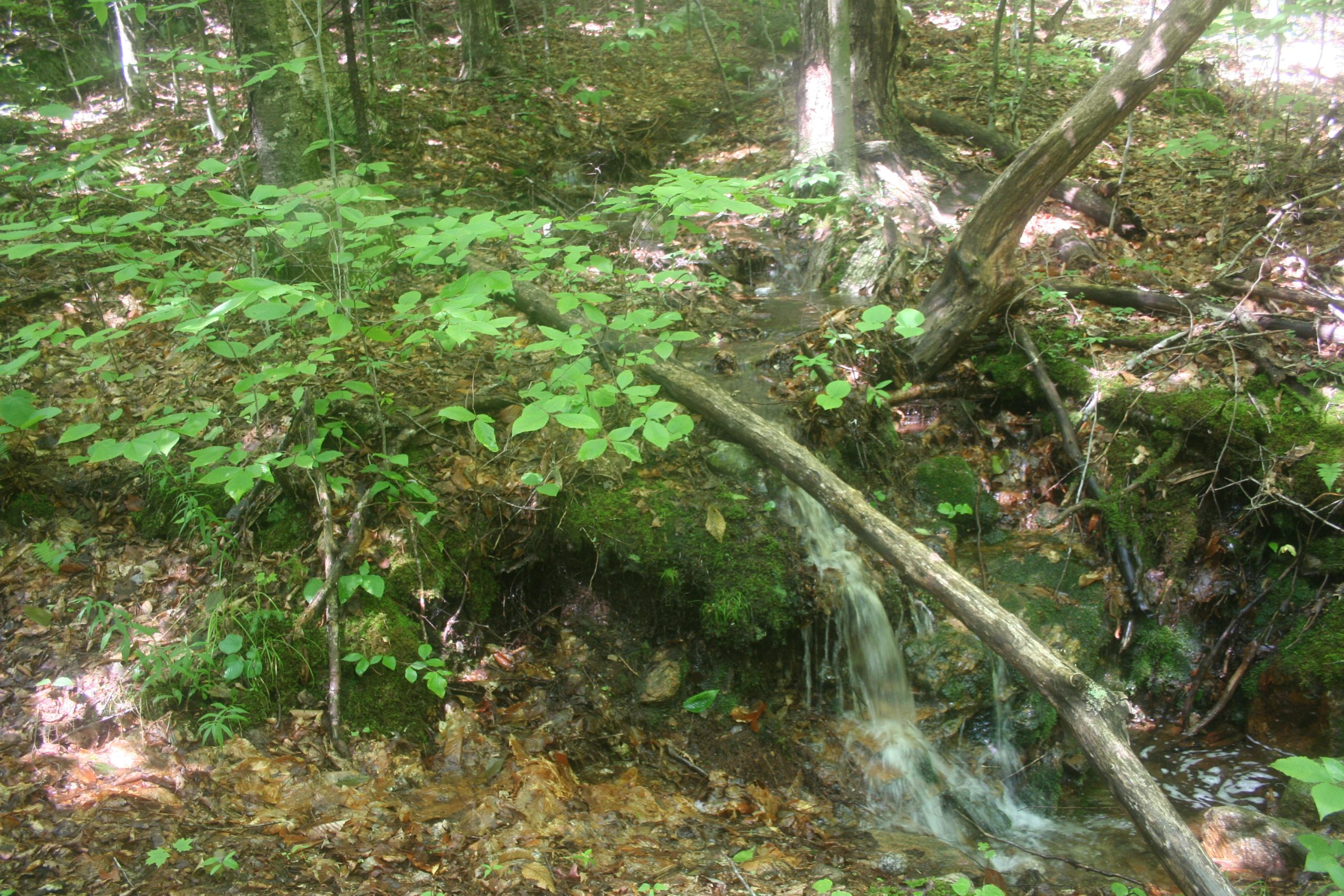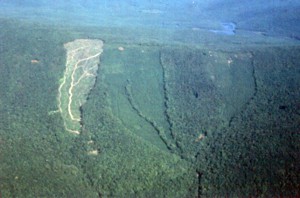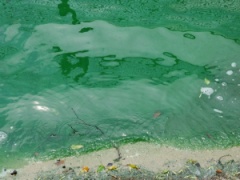Water analysis can tell ecologists the condition of the atmosphere and streams. Plants can tell them what is happening to a stream too. Water was examined and measured at the weather station where it entered this ecosystem. It passed through the system by way of the small stream in the clear-cut and passed out of the system through the weir at the bottom of the ecosystem basin. Changes can occur as water moves down a hillside. Plants can sometimes “tell” what is happening to the water. Plants can also “tell” the stage of a clear-cut area’s recovery.

The boring beetles, carpenter ants, and other insects have a lot of work ahead of them to open up the hardwood logs to fungi and other microorganisms. These will decay the unsightly mess and return raw materials to the soil for recycling into new plants. We can only guess how long it will take from what has been discovered in other places. Up to a hundred years may pass before this area is naturally reforested by the same kinds of trees that were cut. Of course, other plants and trees will help cover the slope at first, changing growing conditions enough for a second group of trees, shrubs, and herbs to grow. The second group of plants would pave the way for a third group. After several stages of succeeding plant groups, conditions might be right for the original type of forest to sprout again and succeed. “Succession” is the word botanists use to describe these changing types of plants in one place. When an area stops changing and can stay the same way for a hundred years or more, botanists say the area has reached its “climax vegetation.”
Lightning fires, drastic weather changes, volcanic eruptions, and other natural events can cause change too. Human activity is not the only factor affecting the vegetation.
Normally a cut forest will have root and stump sprouting the first year. But since the researchers are experimenting in this outdoor laboratory, they have killed the new growth chemically for a few years. They do here what can’t be done indoors or might not be tried on commercial cuts. They are trying to learn what happens to the soil, plants, animals, water, and the microclimate when forests are clear-cut.
Usually in commercial lumbering loggers cut and haul many of the trees away. Roads are built and trucks enter the cut area. Many things happen at once. Here the cut trees are left on the ground so the scientists can study and learn what happens to stream flow when forests are clear-cut. Results won’t be confused by other things happening at the same time. The researchers can compare the cut and uncut areas.
The experimenters picked two pieces of forest as nearly alike as possible. The cut area is the experiment. The uncut area is the “control” that tells what would have happened in the cut area if it hadn’t been cut. After watching the two areas over a period of years, the experimenters will be able to make predictions of changes that will occur when similar areas are logged with this clear-cut method.
Hike through Watershed 4 and you’ll discover strips of forest 160 feet wide next to strips of cut 80 feet wide, like the one you first visited. These are experiments with strip-cutting.

Predictions are only educated guesses. The more measurements taken and the more data gathered, the better the chance of an accurate prediction. That’s why scientists usually qualify their predictions with “usually,” “we think,” “evidence indicates,” “samples show.” It is harder for scientists to make firm statements of fact, to say yes or no, when they must deal with opinions. They want to be accurate and stick to the facts, as far as they are known. Accurate facts are based on much research and data-gathering.
Let’s investigate the clear-cut stream. This area was cut in 1966, and sometimes to understand it the limnologist has to be a botanist too. A limnologist like Gene Likens studies freshwater plants and animals and the physical properties of water. But to be an ecologist, he may have to “turn his hat” a bit more and recall plant physiology from his botany classes.
We can do some of our own observing and make an ecological prediction.
Look closely at the water. Light-green plants edge the stream. The forest streams have these same mushy plants clustered along their banks. But those plants are more yellow-green than this blue-green mass. Does that difference mean anything? Some of the light-green mixes with the blue-green. This stream looks slimy compared to the other streams in the forest, under the trees. There are more blue-green than yellow-green plants in this clear-cut stream than in the forest waters.
The greens you see are named algae. There are two different kinds present. Some are called green and others blue-green algae (pond scum, to most people). They are two entirely different kinds of plant, as different as a pine tree and grass, even though they look very much alike to you. Here you are observing mostly blue-green algae, which grow very well in this stream and choke the steady flow of water.
Water must flow steadily and fairly rapidly or it will start looking like this, polluted. A faster flow rate adds oxygen, takes away decaying materials, and in general cleans up a stream or river.
Why are there more blue-green algae in this stream? Why do they grow better here in the clear-cut? Cutting the trees is the original cause. There is such a lot of plant life decaying or decomposing here. The saprophytes, such as some of the pretty fungi on the logs and stumps or the bacteria, too small for the naked eye to see, are busy with other decomposers like the boring beetle and small grubs. They all break up dead plant parts. Nutrients are being returned to the soil for recycling into new plant life. But there are no new plants to use the freed nutrients. New growth was killed as part of the experiment. The worms, centipedes, and insects that move soil, churning it like cake batter from the top to the bottom, haven’t had time to do their job. So the rains wash extra nutrients, like nitrates, down the hillside into rivulets which join this stream.
Scientists have been measuring nutrient content in the water for over ten years. A heavier load of nitrates is found here than in forest streams. The blue-green algae are clues or indicators that the stream is loaded with a certain kind of nutrient, the nitrates from the decaying plants.
Plants have tolerance limits. The idea of tolerance is complicated when you don’t understand it and simple when you do. Some people can tolerate lots of strawberries. Other people can’t. A person might tolerate a few strawberries, but break out in hives if he ate a lot. Desert plants can tolerate long rainless periods. Ferns can’t tolerate rainless periods. Ferns will die in a desert where catci manage to survive.
Blue-green algae can tolerate more of this nitrate chemical in the water than plain green algae – the green algae won’t grow well and the blue algae grow all right. Not only can the blue-green algae tolerate nitrates and grow, they grow better when they have nitrates. The green algae can’t compete easily, so the needed nutrients that both species must have go into more blue-green algae growth. Instead of a balance between the two species you see mostly blue-green algae.

To our big rivers we add nutrients from our household, yard, and factory wastes. These wastes act like the extra nutrients from the decaying logs. More algae can grow. Then the Hudson, the Delaware, the Schuylkill, and the Potomac can all get polluted just like this little stream.
Some plants are good in streams. They are needed as food for the water animals like microscopic zooplankton, crayfish, and other fish. A balance of plants and animals helps make a clean, healthy river. But most of our big rivers aren’t pure any more, and most of our small ones are getting poisoned and polluted.
If some plants are good, why aren’t more even better? Too many plants make a stream sick, because eventually the plants die and sink to the bottom and then decay. The decaying plants free more nitrates and minerals in waters already overloaded with decaying sewage and other materials dumped into them. More nutrients enable more plants to grow – plants that will die, decay, and free even more nutrients for more plant growth.
The living plants multiply so rapidly in the water and the dead plants are so numerous that detritus builds up on the stream bed. The plants interfere with water flow. The stream slows down. Once the stream slows too much it can no longer keep itself clean. Decaying plants use oxygen but don’t make oxygen. Eventually decaying plants use up all the oxygen and crowd out the living plants and animals. Overpopulation of plants kills the stream or lake that at first joined with the sun, air, and seeds or spores to make new plant life. When there’s no oxygen in a river, the living plants suffocate – they choke themselves to death.
The picture is not a pretty one. Plants need oxygen to decay quickly. When decaying plants use up all the oxygen, the whole stinking mess must just sit like thick, half-rotten soup, emitting the foul smells of slow anaerobic decay – decay without oxygen. The smoothly moving balanced cycle of constant and regulated change comes to a standstill. The nutrients are trapped. No more nutrients will be released to maintain a stream community. No new plants can grow without oxygen and nutrients.
We can make our own prediction from our own observations and the researched facts: mass plant suicide occurs with overpopulation of a water environment! This dramatic final scene of mass organism destruction and the death of an aquatic community is called eutrophication. That one long word, eutrophication, meaning the oversupply of nutrients to water and the overabundant growth of plants, tells an even longer tale.
Soil temperatures rise in the clearing where they are exposed directly to the sun. Yet it is pleasant inside the forest. The leaves on the trees make a great sunshade and their transpiration removes some of the heat from the air, cooling it. The forest is a good air conditioner on a hot summer day.
We move down the hillside and take our car back toward Pleasant View. Riding along, let’s review what we found out at the weir, the weather station, and along the stream in the clear-cut: Water comes into the ecosystem, is measured at the weather station and analyzed for mineral content. Then moving downward toward an ocean, the water sinks into the ground or is used by a plant or animal. If a droplet doesn’t evaporate into the air or become part of an underground stream, it moves along the surface, dissolving soil and chemicals, and pushing debris as it joins other droplets to make a stream. The droplet is measured and tested again at the weir and droplets may help one plant grow better than another, depending on the chemicals the droplet has dissolved. Eventually a droplet evaporates and falls again from a cloud as rain or snow – perhaps on Hubbard Brook, completing the endless chain.
